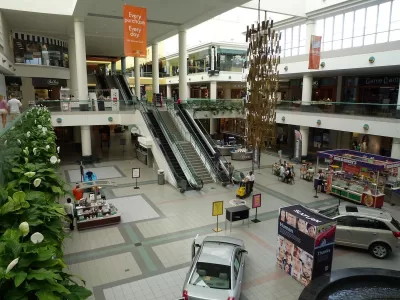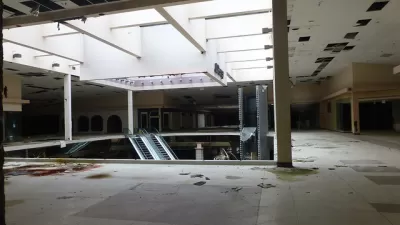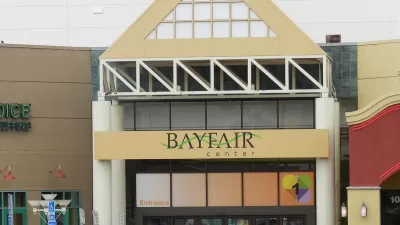The American shopping mall may be closer to its original vision than ever.

In a piece for Governing, Alan Ehrenhalt describes the history and potential future of U.S shopping malls through the lens of two books, Alexandra Lange’s Meet Me by the Fountain (one of Planetizen’s Top Planning Books of 2022) and Kate Black’s Big Mall.
Each book, in its way, responds to the original vision of Victor Gruen, known as the father of American malls. Gruen saw the mall as a place to bring people together.
But if modern shopping malls failed to achieve Gruen’s vision of rewarding community, it’s important to remember that they are profoundly social institutions. This has been true from the very beginning, in ways that Lange and Black document quite precisely. And the current plight of the mall points toward a more public future in which local governments will inevitably play a crucial role.
The decline of the mall in recent years may ironically be the key to getting closer to Gruen’s vision as mall owners and cities reimagine the properties to serve new needs. “In perhaps the most startling transformation, Gruen’s Southdale Center in Minnesota, the first of the fully enclosed malls of the 1950s, is being re-created as a multipurpose development that includes luxury hotel rooms and apartment complexes, a fitness center in place of a defunct J.C. Penney store, medical clinics and day care for children, and a variety of other public and private properties.”
FULL STORY: The Once and Future Shopping Mall

Planetizen Federal Action Tracker
A weekly monitor of how Trump’s orders and actions are impacting planners and planning in America.

Map: Where Senate Republicans Want to Sell Your Public Lands
For public land advocates, the Senate Republicans’ proposal to sell millions of acres of public land in the West is “the biggest fight of their careers.”

Restaurant Patios Were a Pandemic Win — Why Were They so Hard to Keep?
Social distancing requirements and changes in travel patterns prompted cities to pilot new uses for street and sidewalk space. Then it got complicated.

Platform Pilsner: Vancouver Transit Agency Releases... a Beer?
TransLink will receive a portion of every sale of the four-pack.

Toronto Weighs Cheaper Transit, Parking Hikes for Major Events
Special event rates would take effect during large festivals, sports games and concerts to ‘discourage driving, manage congestion and free up space for transit.”

Berlin to Consider Car-Free Zone Larger Than Manhattan
The area bound by the 22-mile Ringbahn would still allow 12 uses of a private automobile per year per person, and several other exemptions.
Urban Design for Planners 1: Software Tools
This six-course series explores essential urban design concepts using open source software and equips planners with the tools they need to participate fully in the urban design process.
Planning for Universal Design
Learn the tools for implementing Universal Design in planning regulations.
Heyer Gruel & Associates PA
JM Goldson LLC
Custer County Colorado
City of Camden Redevelopment Agency
City of Astoria
Transportation Research & Education Center (TREC) at Portland State University
Camden Redevelopment Agency
City of Claremont
Municipality of Princeton (NJ)




























